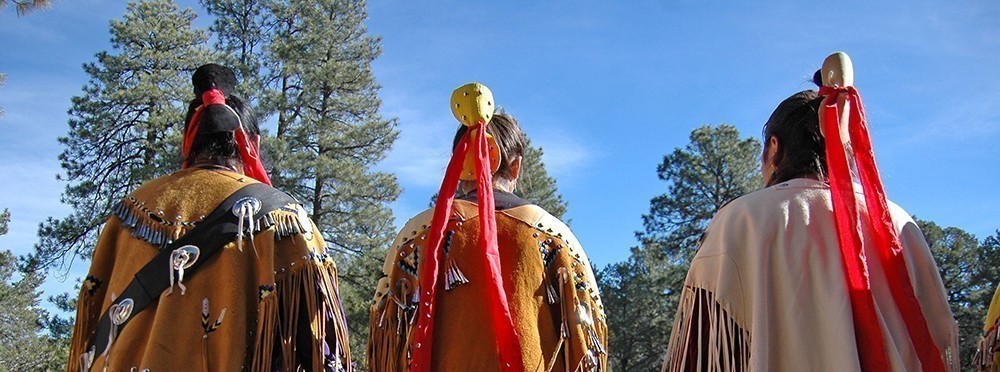
Dishchii' Bikoh' Apache Group from Cibecue, Arizona © Grand Canyon National Park
American Indian and Alaska Native (AIAN) tribes have made strides in terms of working with the U.S. government to plan for disaster. However, participation rates in mitigation programs remain quite low, especially in some of the most disaster prone regions of the nation.
The passing of the 2013 Sandy Recovery Act granted tribes the ability to bypass States and request a disaster declaration from the President as an autonomous government. On March 1, 2013, the first tribal disaster declaration request made directly to the President was granted to the Eastern Band of Cherokee Indians in North Carolina. More than 300 members of the tribe were affected by torrential rain, severe flooding, and landslides, and damages totaled more than $5.4 million. In a press release, Federal Emergency Management Agency (FEMA) official Michael Bolch stated, “this is the first time the Federal Government has worked one-on-one in partnership with a tribal government following a disaster… It is a truly historic moment.” The declaration triggered $3.3 million in federal assistance, of which $1.3 million was contingent on the tribe having a disaster plan in effect.
In contrast, the Cheyenne River Sioux tribe of South Dakota experienced six major disasters since 2008, including several severe storms, blizzards, and heavy snowfall. Even with this recent history of disasters, the tribe does not currently have an approved disaster plan, making them ineligible for crucial federal mitigation project funding.
The experience of the Cheyenne River Sioux tribe is not unusual. As of September 30, 2015, only 117 of 5661 federally recognized tribes had FEMA-approved hazard mitigation plans. This means that more than three-quarters of all tribes are ineligible to apply for FEMA grants and cannot receive federal funding for disaster mitigation projects. In light of the increasing number of climate-induced disasters and the fact that Native communities are more socially and economically vulnerable to disaster than others, it is vital to strengthen voluntary participation in tribal disaster mitigation efforts.
Considering the urgency of the problem, there are remarkably few investigations into how American Indian and Alaska Native disaster policy has been formed and developed. While a few publications are available on the importance of tribal sovereignty in disaster (see Adams, 2012; and Leemon, 2014), little attention is devoted to disaster mitigation planning among tribes or to the ways that tribes apply for federal assistance after an event.
The research presented in this article, which draws on Carter (2016), attempts to fill this void and summarizes a comprehensive policy analysis that included the review of 66 federal documents focusing on disaster mitigation and American Indian tribal sovereignty. In addition, we analyzed FEMA tribal disaster declaration data and tribal mitigation planning data so we could assess the level of mitigation planning and engagement among American Indian and Alaska Native (AIAN) tribes.
Vulnerabilities
Scholars of social vulnerability and disaster have long recognized that socially and economically marginalized racial and ethnic minorities experience higher levels of risk and loss (Fothergill et al., 1999; Dash, 2013). Although much of the literature focuses on the two largest racial and ethnic minority groups in the United States—African Americans and Latinos—there is growing recognition that American Indians and Alaska Natives might also face special risks in disaster because of the intersection of economic, demographic, physical, and cultural factors.
Consider the following: In 2015, 28.3 percent of AIAN individuals lived below the poverty line, which is more than twice the national average. Educational attainment among this population is among the lowest in the nation. Native American youth are more likely to drop out of high school than any other racial or ethnic group in the United States. According to a 2012 report from the U.S. Interagency Council on Homelessness, although only 1.2 percent of the national population identifies as AIAN, 4 percent of all sheltered homeless persons and 4.8 percent of all sheltered homeless families self-identify as Native American or Alaska Native. The same report revealed that nearly one in five people (19 percent) on tribal lands are living in conditions considered “overcrowded” and much of that housing is lacking basic plumbing and kitchen facilities (also see Fogarty, 2004). Native Americans suffer from chronic and acute illnesses such as diabetes, heart disease, and tuberculosis at rates up to 600 percent higher than the national average. They also have substance-abuse rates that far exceed the national average with American Indian individuals 510 percent more likely to suffer from alcoholism. Additionally, they are twice as likely as any other racial group to die before the age of 24—with suicide being the second highest cause of death for 15-24 year olds (Horowitz, 2014).
These vulnerability indicators are exacerbated by more frequent and intense disaster threats in tribal areas. In the past four decades, 120 disasters have affected tribal areas, according to FEMA disaster declaration records.2 The number of disasters has increased steadily over time, and 2010-2016 had the most tribal disasters on record (see Figure 1).
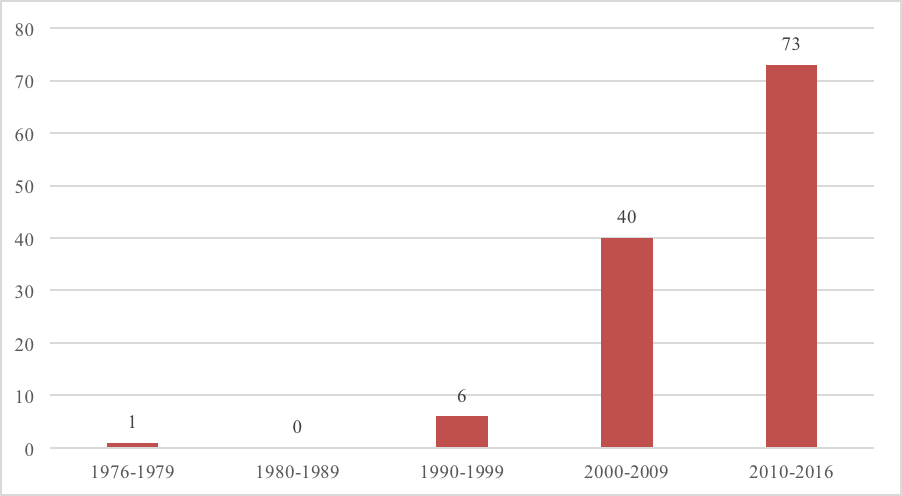
Figure 1: Number of Tribal Disaster Declarations by Decade (1976-2016)3
The most common type of disaster experienced by tribes is severe storms, accounting for 59 of the 120 disaster declarations since 1976. Tribal areas have also been routinely affected by floods and fires, as well as several other natural hazards (see Table 1).
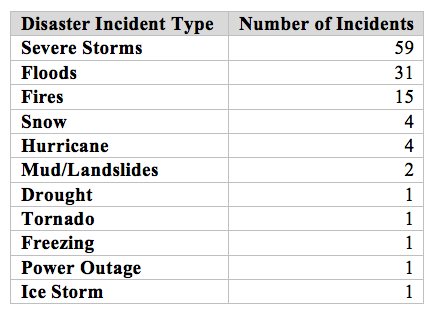
Table 1: Disaster Incident Types (1976-2015)
Sandy Recovery Improvement Act
Programs under the authority of FEMA, such as their Hazard Mitigation Grant Program, Public Assistance, and Pre-Disaster Mitigation project funding, are the key mechanisms through which tribes may receive technical and financial assistance for mitigating hazards. However, until recently, tribes were unable to request a disaster declaration as a grantee. Instead, the governor of their state had to request a declaration on their behalf. Tribes had the option to request a disaster declaration as a sub-grantee, but some deemed this process a violation of tribal sovereignty.4 After all, the ability to self-govern and to protect and enhance the health, safety, and welfare of tribal citizens within a tribal territory is essential to the concept of tribal sovereignty (Leemon, 2014).
The status of tribes changed in 2013 when the Sandy Recovery Improvement Act was passed, which ultimately led to the amendment of the 1988 Robert T. Stafford Act. The amendment recognized tribes as distinct from local governments and gave tribes a direct channel to request a presidential disaster declaration. Since then, seven tribes have used this method, side-stepping states in the process.
As mentioned above, the first tribe to apply directly for federal disaster assistance was the Eastern Band of the Cherokee Nation. The tribe requested a disaster declaration on February 14, 2013, and after this request was granted on March 1, FEMA arrived within two days. The whole process was labeled a success by the tribe and by FEMA.
“We did not necessarily anticipate being the first tribe to receive the declaration. But I think through the recent disaster that we had with all of the flooding, we’re glad that we could set a stage for other tribes throughout the nation,” Eastern Band of Cherokee Indians Principal Chief Michell Hicks told Indian Country Today. “The unfortunate part of this is that we have the damage. The fortunate part of this is that we are helping to set a good precedent for tribes to seek assistance working directly with the President through FEMA” (Indian Country Today Media Staff, 2013).
The Karuk tribe of California is another tribe that received a Presidential Disaster Declaration after the passage of the Sandy Recovery Improvement Act. The Karuk were affected by a wildfire that raged between July 29 and August 2, 2013. The fire damaged 32 houses and destroyed 85 acres of tribal land. Tribal Self-Governance Coordinator Jaclyn Goodwin reported that the FEMA Region X Office in San Francisco assisted the tribe with the disaster declaration. “They guided us through all the necessary paperwork and all the back-up documentation that we needed to provide them,” she told Indian Country Today (Daffron, 2013).
Because they had FEMA-approved hazard mitigation plans in place, the Eastern Band of Cherokee Indians and the Karuk were able to successfully use the new streamlined disaster declaration process. Yet, since only 20 percent of federally recognized tribes have such plans, the vast majority are ineligible to participate the FEMA mitigation process.
Tribes and tribal areas
The FEMA dataset that we used for our analysis included information for 566 federally recognized tribes. Those tribes were not distributed evenly across the United States or across the ten FEMA regions. Indeed, the number of tribes varies dramatically by region (see Figure 2 and Table 2), with the highest number of tribes located in FEMA Region X (where there are 270 tribes, with 228 tribes in Alaska alone), and the fewest in Region III (where there are no federally recognized tribes).
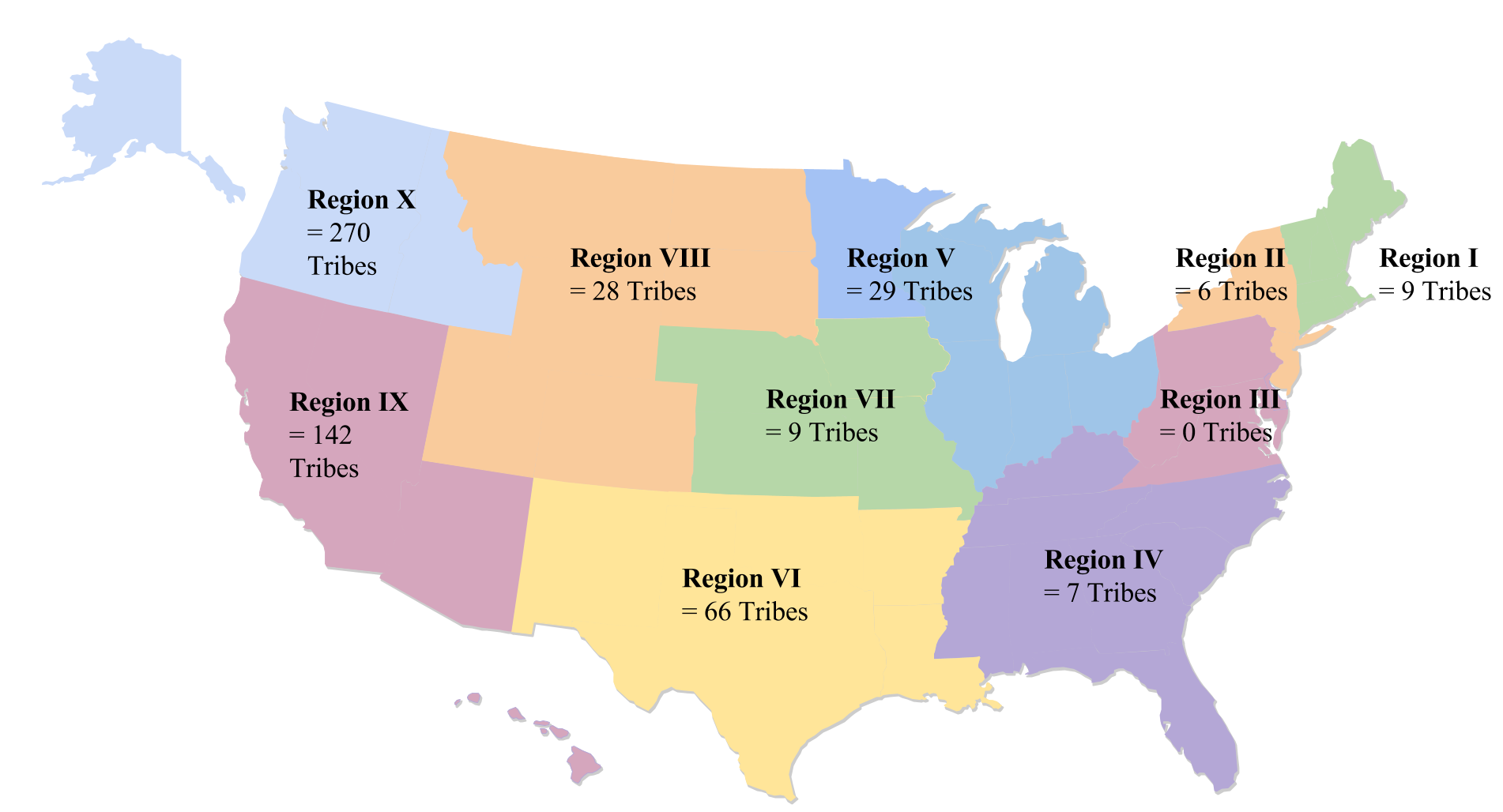
Figure 2: Map of Ten FEMA Tribal Regions with Number of Tribes per Region
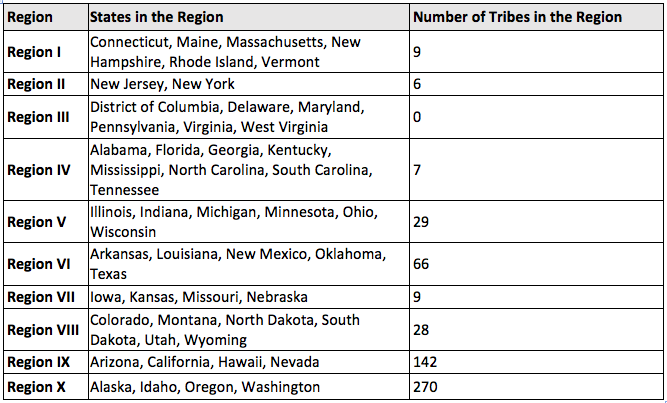
Table 3: Ten FEMA Tribal Regions by State and Number of Tribes
Hazard mitigation plans
Not only do the number of tribes vary across the FEMA regions, but so does the number of tribes engaged in disaster mitigation planning. As shown in Table 4, Region I, which includes Connecticut, Maine, Massachusetts, and Rhode Island, has the highest proportion of approved plans per tribe, with six of the nine tribes (66.7 percent) having mitigation plans. Conversely, in Region X—which spans Alaska, Idaho, Oregon and Washington—only 24 of the 270 tribes (8.9 percent) have FEMA approved hazard mitigation plans in effect. In Alaska, the state with the largest number of tribes, FEMA reports that just 3 of the 228 tribes (1.31 percent) have currently approved disaster plans.
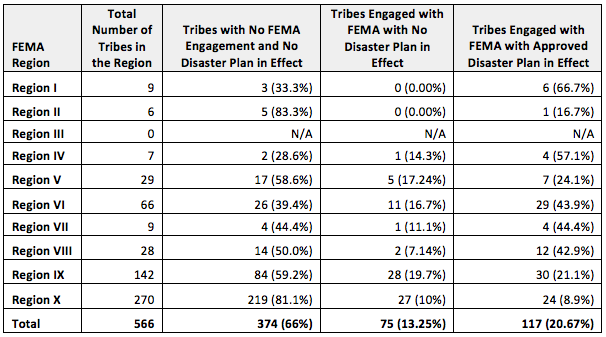
Table 4: 2015 Regional Comparison of Tribes Regarding Disaster Planning Status
The low rates of participation across the FEMA tribal regions is worthy of concern. But the uniquely low rates in Region X, and in Alaska in particular, are especially alarming. Native Alaskans have been bearing the brunt of climate-induced disasters, and their struggles have been well documented in academic literature and news articles. More than a decade ago, the Government Accountability Office (GAO) found that flooding and erosion affected 184 of 213 Alaskan Native villages (86 percent) due to sea level rise. In a 2009 report, the GAO concluded that 31 villages were in “imminent danger” from climate-induced disasters (GAO, 2009).
The Alaskan village of Newtok—home to the Yupik people—has recently been in the news. Newtok has fallen victim to rising sea levels and its inhabitants have seen as much as 100 feet of land disappear into the ocean each year. The village also has high rates of poverty, social isolation, and poor health outcomes. The tribe, although motivated to plan for climate-induced disasters, has struggled to raise the estimated $130 million in funds needed to move their village to higher ground (Semuels, 2015).
Challenges for tribal disaster preparedness
With the rising number of disasters across the nation and the alarming toll of these events in vulnerable tribal areas, the need to tackle this escalating issue is more salient than ever. Yet, cost barriers to tribal mitigation planning and action are real. With cutbacks for disaster mitigation activities at the local, state, and federal level, there is decreased capacity to assist tribes with disaster management. In addition, as Rod Mendez, director of emergency services for the Hoopa Valley tribe of California, said in April 2013 that “most tribes don’t have plans because they haven’t had money for plans” (FEMA, 2013: 15).
While some federal funding is available for disaster mitigation planning, producing a disaster mitigation plan can still be a daunting process for smaller tribes. A typical disaster mitigation plan for a tribe may range between 100-500 pages depending on the size of tribe. This paperwork requires many technical assessments that must be conducted by engineers and surveyors. For smaller tribes that do not have dedicated emergency management teams, the production of a mitigation plan or of a grant application could be nearly impossible without outside assistance. Indeed, FEMA Administrator Craig Fugate told U.S. Senate Committee on Indian Affairs in 2011 that “many tribes don’t have the ability, because of the complexity of the programs and the size of the tribe, to serve as a grantee because of the financial oversight requirements” (U.S. Senate, 2011: 14).
Physical isolation represents another challenge in the planning process. In Alaska, for example, 42 percent of the AIAN population are living in areas not accessible by a road (Goldsmith, 2008). Other tribes are located in similarly remote regions of the United States, especially in the West.
This physical isolation is amplified by culturally-based communication challenges and mistrust of government authorities. Some American Indian and Alaska Native governments have reported experiencing difficulty balancing traditional beliefs with modern, westernized approaches to mitigation planning. As Redsteer et al. (2013) argue, federal frameworks often do not appreciate traditional knowledge viewpoints that account for culturally sacred sites and culturally specific resource management practices: “If sacred sites are not recognized, there is a substantial chance of increased conflict, which would constrain or even derail efforts to maintain resilient cultural and natural resources” (Redsteer et al., 2013: 396).
The very concept of planning for disaster represents a cultural barrier for some tribes, as tribal members may hold deep-rooted beliefs that the very act of planning potentially causes disaster. The following excerpt from the Navajo Nation Multi-Hazard Mitigation Plan illustrates this challenge: “The Navajo Nation and the Navajo People (Dinė) find the subject of hazard mitigation hard to speak of and hard to prepare for. The idea of preparing for disaster from a traditional point of view is asking for disaster. One plans for the future wellbeing of one’s family, the planting of crops, or the shearing of sheep. One does not plan for the proverbial rainy day, because it may offend the rain.”
Even if these challenges are overcome and a plan is submitted for FEMA approval, there is no guarantee that a plan will be accepted on the first review. Multiple revisions may be and often are required before a final copy is approved. FEMA also requires that a tribe’s hazard mitigation plans be updated every five years. As of September 30, 2015, 42 tribes have expired disaster plans, rendering them ineligible for disaster mitigation funding in the event of a sudden disaster. A tribe may submit a plan after an event but this is a difficult task when overwhelmed by the disaster.
Future suggestions
Recent legislative changes have led to more direct access among American Indian and Alaska Native tribes to the federal government. Yet, planning costs, the inability to access technical experts, physical isolation, and cultural differences remain as serious challenges to tribal participation in disaster mitigation planning.
The rising number of disasters affecting tribal areas and the fact that 449 of 566 federally recognized tribes do not have a FEMA-approved disaster mitigation plan underscores the urgency of making planning participation for tribes a priority for both federal and tribal governments. In order to make this a reality, we suggest several immediate actions.
First, the low participation rates are disturbing and there is thus much to be learned about why so many tribes are not engaging in the FEMA mitigation planning process and why it varies so much by region. FEMA has a dedicated Tribal Affairs Branch and Regional Tribal Liaisons for each of the ten FEMA regions. How this branch and the liaisons work with the tribes, and how receptive the tribes are to these outreach efforts, has not been systematically documented. Further investigation into these relationships and other potential barriers to participation is clearly warranted.
Second, the disaster data that we analyzed (see Carter, 2016, for complete results) indicate that some tribes have experienced repetitive losses, yet still have not engaged with FEMA to mitigate future disasters. These tribal disaster hotspots should be prioritized for immediate outreach from FEMA Regional Tribal Liaisons and other emergency preparedness experts to encourage mitigation planning. Technical and financial support should be provided to facilitate this as soon as possible.
Third, disaster mitigation planning is only likely to be successful if other forms of social, economic, and environmental vulnerability are addressed. As such, we believe that disaster mitigation planning can and should be tied to other efforts to move toward more socially just and equitable tribal policies.
Fourth, the minority of tribes that have actively engaged with FEMA and have approved hazard mitigation plans available may serve as exemplars and even guides for other tribes. These tribes should be invited to share the lessons they have learned during the process and the technical and financial resources they drew upon to successfully plan and mitigate. There are many lessons to be learned from these mitigation leaders, and future research should document their trials and triumphs with the planning process.
References
Adams, Heidi. 2012. “Sovereignty, Safety, and Security: Tribal Governments under the Stafford and Homeland Security Acts.” American Indian Law Journal 1(2): 127-146.
Carter, Lucy. 2016. “An Investigation of United States Federal Policy Attempts to Reduce American Indian and Alaska Native Disaster Vulnerability.” Masters Thesis, Department of Sociology, Colorado State University.
Cutter, Susan L., Bryan J. Boruff, and W. Lynn Shirley. 2003. “Social Vulnerability to Environmental Hazards.” Social Science 84(2): 242-261.
Dash, Nicole. 2013. “Race and Ethnicity.” Pp. 113-137 in Social Vulnerability to Disasters, 2nd ed., edited by Thomas, D. S. K., B. D. Phillips, W. E. Lovekamp, and A. Fothergill.
Daffron, Brian. 2013. “6 Tribes that Took Advantage of Amendment for FEMA Relief in 2013.” Indian Country Today Media Network, December 6, 2013. http://indiancountrytodaymedianetwork.com/2013/12/06/6-tribes-took-advantage-amendment-fema-relief-2013-152597 (accessed on March 30, 2016.)
Federal Emergency Management Agency. 2010. “Tribal Policy.” Washington, DC: Department of Homeland Security. https://www.fema.gov/media-library/assets/documents/25324 (accessed on September 29, 2015)
Federal Emergency Management Agency. 2013. “National Tribal Consultation Closing Conference Call-April 18, 2013, 3:00 pm Eastern.” Washington, DC: Department of Homeland Security
Federal Emergency Management Agency. 2015. What is Disaster Mitigation? Washington, DC: Department of Homeland Security. Updated November 11, 2015. https://www.fema.gov/what-mitigation (Accessed March 17, 2016.)
Fothergill, Alice, Enrique G. M Maestas, and JoAnne D. Darlington. 1999. “Race, Ethnicity, and Disaster in the United States: A Review of the Literature.” Disasters 23(2): 156-73.
Gautam, Mahesh. R., Karletta Chief, and William J. Smith, Jr. 2014. “Climate Change in Arid Lands and Native American Socioeconomic Vulnerability: The Case of the Pyramid Lake Paiute Tribe.” Pp. 77-91 in Climate Change and Indigenous Peoples in the United States, edited by J. K. Maldonado, C. Benedict, and R. Pandya. Gewerbestrasse: Springer International Publishing GB.
Goldsmith, Scott. 2008. “Understanding Alaska’s Remote Rural Economy.” Institute of Social and Economic Research. Anchorage: University of Alaska.
Government Accountability Office. 2003. “GAO-04-142, Alaska Native Villages: Most Are Affected by Flooding and Erosion, but Few Qualify for Federal Assistance.” Washington, DC: Government Accountability Office. http://www.gao.gov/new.items/d09551.pdf (accessed on October 31, 2015)
Government Accountability Office. 2009. “GAO-09-511, Alaska Native Villages: Limited Progress Has Been Made on Relocating Villages Threatened By Flooding and Erosion.” Washington, DC: Government Accountability Office. http://www.gao.gov/new.items/d04142.pdf (accessed on October 2, 2015.)
Horowitz, Sari. 2014. “The Hard Lives – and High Suicide Rate – of Native American Children on Reservations.” The Washington Post. March 9, 2014. https://www.washingtonpost.com/world/national-security/the-hard-lives--and-high-suicide-rate--of-native-american-children/2014/03/09/6e0ad9b2-9f03-11e3-b8d8-94577ff66b28_story.html. (accessed on March 25, 2016)
Indian Country Media Today Network Staff. 2013. “Eastern Band of Cherokee Indians First to Receive Disaster Aid Under Amended Law.” Indian Country Media Today Network, March 2, 2013. http://indiancountrytodaymedianetwork.com/2013/03/02/eastern-band-cherokee-indians-first-receive-disaster-aid-under-amended-law-147964 (accessed on March 30, 2016).
Leemon, Elizabeth, S. 2014. “A Voice in the Storm: Tribal Consultation in the Wake of the Sandy Recovery Improvement Act of 2013.” American Indian Law Journal 2(2): 589-606.
Redsteer, Margaret .H., Kirk Bemis, Karletta Chief, Mahesh Guatuam, Beth Rose Middleton, Rebecca Tsosie et al. 2013. “Unique Challenges Facing Southwestern Tribes.” Assessment of Climate Change in the Southwest United States: A Report Prepared for National Climate Assessment. Washington, DC: Island Press.
Semuels, Alana. 2015. “The Village that Will be Swept Away” The Atlantic. August 30, 2015. http://www.theatlantic.com/business/archive/2015/08/alaska-village-climate-change/402604/ (accessed on March 20, 2016.)
U.S. Interagency Council on Homelessness. 2012. “Report on Homelessness among American Indians, Alaska Natives, and Native Hawaiians.” https://www.usich.gov/tools-for-action/report-on-homelessness-among-american-indians-alaska-natives (accessed on April 21, 2016).
U.S. Senate Committee on Indian Affairs. 2011. “Floods and Fires: Emergency Preparedness for Natural Disasters in Native Communities.” Washington, DC: U.S. Senate.
-
While there are currently 567 federally recognized tribes in the United States, in this article we report on the status of the 566 tribes included in the FEMA dataset we acquired for analysis for this project. ↩
-
Data retrieved from https://www.fema.gov/data-visualization on November 15, 2015. FEMA and the Federal Government cannot vouch for the data or analyses derived from these data after the data have been retrieved from the Agency’s website(s) and/or Data.gov ↩
-
1976 was the first year a tribal disaster incident triggered a disaster declaration. ↩
-
Under U.S. law, federally recognized tribes are considered domestic dependent nations who are not under the jurisdiction of states. The ability for tribes to govern and protect may be jeopardized if a state government is able to block the disaster mitigation process by breaking the direct line to government that tribal sovereign status requires. ↩
